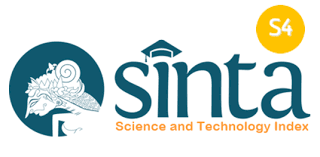ANOSMIA SYMPTOMS AND RT-PCR SWAB RESULTS IN COVID-19 DIAGNOSTICS

Downloads
Coronavirus Disease-19 (Covid-19) is an infectious disease that has become a pandemic since March 11, 2020. PCR (Polymerase chain reaction) swab is a definitive diagnostic tool for Covid-19, because it has a high level of sensitivity and specificity. One of the symptoms of this infection is anosmia. This study aimed to determine the relationship between the symptoms of anosmia and the positive RT-PCR swab results in Covid-19 diagnostics. This study used a systematic review and meta-analysis method that was in accordance with PRISMA. From 16 articles that met the inclusion and exclusion criteria, we selected 12 articles through EPHPP that reported smell disorder among Covid-19 patients. Four reports studied whether smell disorder was independently associated with Covid-19 diagnosis. The frequency of anosmia ranged between 7,5-95%. Anosmia has high specificity for detecting Covid-19 but has low sensitivity. There was a strong relationship between anosmia symptoms and positive RT-PCR swab results. This showed that anosmia can be a marker for patients to carry out further investigations.
Antonelli, M. et al. (2021). Optimal symptom combinations to aid COVID-19 case identification: Analysis from a community-based, prospective, observational cohort. Journal of Infection, 82(3), pp.384-390. doi:10.1016/j.jinf.2021.02.015. Available at: <https://www.ncbi.nlm.nih.gov/pmc/articles/PMC7881291/>
Basu, B. et al. (2020). COVID-Anosmia Checker: A rapid and low-cost alternative tool for mass screening of COVID-19. doi:10.1101/2020.10.28.20221200. Available at: <https://www.medrxiv.org/content/10.1101/2020.10.28.20221200v2>
Butowt, R. and Bartheld, C. (2020). Anosmia in COVID-19: Underlying Mechanisms and Assessment of an Olfactory Route to Brain Infection. The Neuroscientist, doi:10.1177/1073858420956905. Available at: <https://www.ncbi.nlm.nih.gov/pmc/articles/PMC7488171/>
Callejon-Leblic, M., et al (2021). Loss of Smell and Taste Can Accurately Predict COVID-19 Infection: A Machine-Learning Approach. Journal of Clinical Medicine, 10(4), p.570. doi:10.3390/jcm10040570. Available at: <https://www.ncbi.nlm.nih.gov/pmc/articles/PMC7913595/>
Eyheramendy, S. et al (2021). Improved screening of COVID-19 cases through a Bayesian network symptoms model and psychophysical olfactory test. doi:10.1101/2021.01.18.21249821. Available at: <https://www.medrxiv.org/content/10.1101/2021.01.18.21249821v3.full>
Feehan, A. et al (2021). The importance of anosmia, ageusia and age in community presentation of symptomatic and asymptomatic SARS-CoV-2 infection in Louisiana, USA; a cross-sectional prevalence study. Clinical Microbiology and Infection, 27(4), pp.633.e9-633.e16. doi: 10.1016/j.cmi.2020.12.029. Available at: <https://www.ncbi.nlm.nih.gov/pmc/articles/PMC7787079/>
Miller, D. et al (2021). COVID-19 test positivity: predictive value of various symptoms in a large community-based testing program in California. doi:10.1101/2021.03.03.21252014. Available at: <https://www.medrxiv.org/content/10.1101/2021.03.03.21252014v1.full>
Hwang, CS (2006) ‘Olfactory neuropathy in severe acute respiratory syndrome: report of a case', Acta Neurol Taiwan. 15(1), pp. 26–28.
Jeyashree, K. et al. (2021) ‘Self-reported and clinically identified loss of smell and taste among persons tested for COVID-19 in Chennai, southern India, July-August 2020: A cross sectional study', Clinical epidemiology and global health, 11: p. 100718. doi:10.1016/j.cegh.2021.100718
Leal, FE., Mendes-Correa, MC., Buss, LF., Costa, SF., Bizario, JCS., de Souza, SRP., Thomaz, O., Tozetto-Mendoza, TR., Villas-Boas, LS., de Oliveira-da Silva, LC., Grespan, RMZ., Capuani, L., Buccheri, R.,
Domingues, H., Alexander, N., Mayaud, P., Sabino, EC, (2021) ‘Clinical features and natural history of the first 2073 suspected COVID-19 cases in the Corona Sí£o Caetano primary care programme: a prospective cohort study', BMJ Open. 11(1) p. e042745. doi: 10.1136/bmjopen-2020-042745. PMID: 33436471; PMCID: PMC7805372.
Miller, D., Morrow, S., Califf, R., Kaiser, C., Kapur, R., Starsiak, C., Mega, J. and Marks, W., (2021) ‘COVID-19 test positivity: predictive value of various symptoms in a large community-based testing program in California', BMJ. doi: https://doi.org/10.1101/2021.03.03.21252014
Meng, X., Deng, Y., Dai, Z. and Meng, Z., (2020) ‘COVID-19 and anosmia: A review based on up-to-date knowledge', American Journal of Otolaryngology, 41(5).
Owusu, M., Sylverken, AA., Ankrah, ST., El-Duah, P., Ayisi-Boateng, NK., Yeboah, R., Gorman, R., Asamoah, J., Binger, T., Acheampong, G., Bekoe, FA., Ohene, SA., Larsen-Reindorf, R., Awuah, AA., Amuasi, J., Owusu-Dabo, E., Adu-Sarkodie, Y., Phillips, RO, (2020) ‘Epidemiological profile of SARS-CoV-2 among selected regions in Ghana: A cross-sectional retrospective study', PLoS One, 15(12), doi: 10.1371/journal.pone.0243711. PMID: 33301533; PMCID: PMC7728229.
Paltiel, AD., Zheng, A., Walensky, RP., (2020) ‘Assessment of SARS-CoV-2 Screening Strategies to Permit the Safe Reopening of College Campuses in the United States', JAMA Netw Open. 3(7), doi:10.1001/jamanetworkopen.
Ceron, DS. et al. (2020) ‘Self-reported loss of smell without nasal obstruction to identify COVID-19, The multicenter Coranosmia cohort study', J Infect. 2020 Oct;81(4):614-620. doi: 10.1016/j.jinf.2020.07.005. Epub 2020 Jul 7. PMID: 32650110; PMCID: PMC7338860. Available at: https://pubmed.ncbi.nlm.nih.gov/32650110/
Trubiano, JA. et al. (2020) ‘ COVID-MATCH65-A prospectively derived clinical decision rule for severe acute respiratory syndrome coronavirus 2', PLoS One. 2020 Dec 9;15(12):e0243414. doi: 10.1371/journal.pone.0243414. PMID: 33296409; PMCID: PMC7725390. Available at: https://pubmed.ncbi.nlm.nih.gov/33296409/
Von Bartheld, CS. Hagen, MH. Butowt, R. (2020) ‘Prevalence of Chemosensory Dysfunction in COVID-19 Patients: A Systematic Review and Meta-analysis Reveals Significant Ethnic Differences'. Preprint. medRxiv. 2020;2020.06.15.20132134. Published 2020 Jun 17. doi:10.1101/2020.06.15.20132134. Available at: https://www.ncbi.nlm.nih.gov/pmc/articles/PMC7310651/
WHO. (2020) ‘Coronavirus disease (COVID-19)'. Who.int. Available at: https://www.who.int/emergencies/diseases/novel-coronavirus-2019/question-and-answers-hub/q-a-detail/coronavirus-disease-covid-19#:~:text=symptoms
WHO. (2020) ‘Weekly Epidemiological Update on Covid-19' Who. int. Available at: https://www.who.int/publications/m/item/weekly-epidemiological-update-on-covid-19---20-april-2021
Zayet, S. et al. (2021) ‘Contribution of anosmia and dysgeusia for diagnostic of COVID-19 in outpatients'. Infection. 2021;49(2):361-365. doi:10.1007/s15010-020-01442-3 Available at: https://www.ncbi.nlm.nih.gov/pmc/articles/PMC7221233/
Copyright (c) 2022 Vincent Geraldus Enoch Lusida, Denillia Limawan, Fabilla Faiz Arifin, Nabilah Puspa Utami, Raudhatuzzahra Kesuma, Jihan Qonitatillah, Nida` Fahima Amatullah, Subur Prajitno

This work is licensed under a Creative Commons Attribution-ShareAlike 4.0 International License.
- The journal allows the author to hold the copyright of the article without restrictions.
- The journal allows the author(s) to retain publishing rights without restrictions.
- The legal formal aspect of journal publication accessibility refers to Creative Commons Attribution Share-Alike (CC BY-SA).
- The Creative Commons Attribution Share-Alike (CC BY-SA) license allows re-distribution and re-use of a licensed work on the conditions that the creator is appropriately credited and that any derivative work is made available under "the same, similar or a compatible license”. Other than the conditions mentioned above, the editorial board is not responsible for copyright violation.































